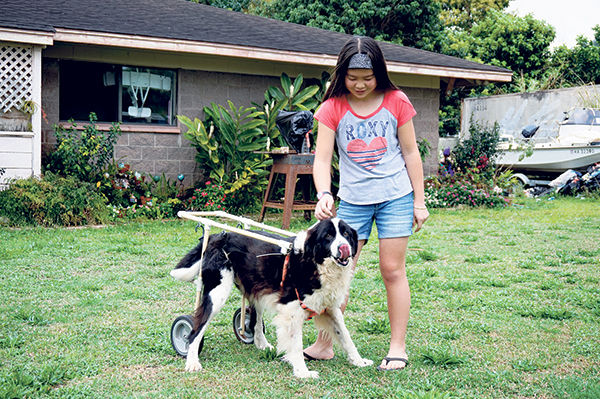LIHUE — When her best friend was barely able to walk, Haley Gokan sought a solution. Her best friend, Harley, a 13-year-old Border Collie mix, was diagnosed at a young age with canine degenerative myelopathy. And when Harley’s hind limbs
LIHUE — When her best friend was barely able to walk, Haley Gokan sought a solution.
Her best friend, Harley, a 13-year-old Border Collie mix, was diagnosed at a young age with canine degenerative myelopathy. And when Harley’s hind limbs started to drag and wobble, it tugged at the Kapaa Middle School student’s heart.
“He’s part of my childhood,” said Gokan, who’s 13 just like Harley. “I remember I use to ride on his back before the disease started. He’s one of the happiest dogs I’ve ever seen and I don’t think I would have chosen another dog over him.”
CDM affects the spinal cord in older dogs and causes a loss of mobility and coordination. The disease usually affects a dog that is between 8 and 14 years old and it worsens until they can’t walk. There’s no cure for the ailment.
“I felt really bad,” said Gokan, who has had Harley by her side as long as she’s been alive. “It didn’t seem like he would last this long, I’m happy that he’s still around.”
Then Gokan remembered something from her past that helped spring her into action.
Her grandfather had wanted a prosthetic arm after he lost his real one to cancer, so when Gokan researched prosthetic limbs, she came across some information on how to create a plastic canine wheelchair.
Using an app from software called 123D Design, which showed her a 3D model of the wheelchair, Gokan constructed the device out of PVC pipes, connectors, a harness, wheels and bungee cords.
But as she was creating the second of three prototypes, Harley took a turn for the worse.
Gokan returned home from school one day and saw her dog had gotten out of his cage.
After looking around, she found Harley lying in her backyard. Gnawing at her was the fear that she wouldn’t be able to help her friend in time.
“I was really worried that he was going to pass soon,” said Gokan, who likened the disease to ALS, or myotrophic lateral sclerosis in humans, which affects nerve cells in the brain and spinal cord causing a loss of muscle control. “I was scared and I think I felt a little bit of panic. I felt that I needed to make the prosthetic wheelchair work. It had to work.”
And work it did.
After five weeks of labor, Gokan completed the wheelchair. Not only did it help her dog roll around, she entered it into the Kauai District Science and Engineering Fair at the Kauai Memorial Convention Hall.
Cherish Gokan said her daughter’s device got rave reviews. Several people said it would have helped their dogs.
Here’s how it works: Gokan slips Harley’s front legs into a harness with two, small PVC pipes attached to the back it. Gokan then secures the harness to his back and places two longer PVC pipes into the connectors, attaching Harley completely to the chair. After Gokan secures Harley’s hind legs with the bungee cords at the back of the wheelchair, the two friends are ready to roll.
“I’m just amazed at what she did,” Cherish Gokan said. “It’s all her. She did her research. I’m so proud of her.”
Although Gokan didn’t win an award for her efforts, the middle schooler stated the real prize was helping her best friend.
Harley, by the way, loves his new chair.
“Whenever he sees me wheeling it down toward him, he gets all excited, like he’s ready to walk all over the yard,” Gokan said. “He can go in circles and he can walk a lot farther than he could without it.”
Just like the old times — almost. Haley doesn’t ride her old companion like she did back in the day, but the two are still getting around together.
“I felt so great because I know that the wheelchair betters the life,” Gokan said. “I felt really good that I could do something to help him.”
•••
Averie Soto, staff writer, can be reached at 245-0452 or asoto@thegardenisland.com.


